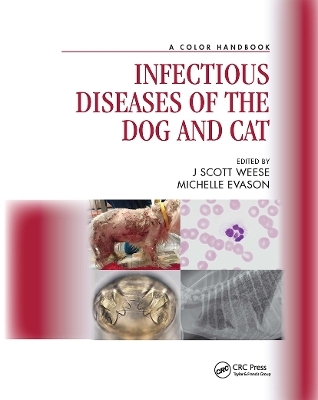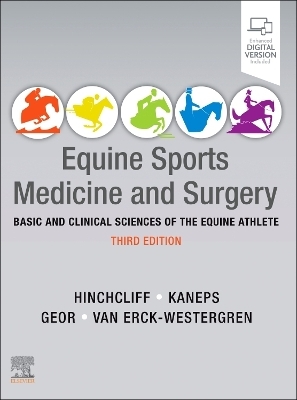
Infectious Diseases of the Dog and Cat
Taylor & Francis Ltd (Verlag)
978-1-032-57010-5 (ISBN)
The field of infectious diseases in veterinary medicine is both rewarding and challenging, and this book offers small animal veterinarians a lifeline by balancing relevant background, guidance and optimizing efficiency. It provides a pathway for clinicians through this complex field by highlighting the most clinically relevant aspects of a wide range of diseases, and granting them consideration for placement on dog and cat differential lists. Organized according to a system-based structure, all the major clinically affected systems are covered along with a catch-all multisystem chapter for infectious diseases that escape easy classification.
The book is clinically oriented, based on experience underpinned by published research data. Pathogen-specific information enables rational choice of diagnostics, therapy, and prognostication for a complete list of small animal infectious diseases, that includes bacterial, viral, parasitic/protozoal and fungal pathogens. This concise reference guide will be an invaluable tool for clinicians as they develop their understanding of, and ability to communicate about, infectious diseases of the dog and cat.
Key features:
Provides a clinically oriented quick reference guide
Includes all major small animal infectious diseases
Contains over 300 superb color illustrations
Scott Weese is a veterinary internist and microbiologist, chief of infection control at University of Guelph Ontario Veterinary College Health Sciences Centre, and Canada Research Chair in zoonotic diseases. As editor in chief of Clinician’s Brief, Dr. Weese provides quintessential expertise on infectious and zoonotic diseases (particularly of companion animals), infection control, and antimicrobial therapy. Scott is also co-editor of Equine Clinical Medicine, Surgery and Reproduction published by CRC press. Michelle Evason is a veterinary internist at the University of Prince Edward Island Atlantic Veterinary College. She has worked in companion animal specialty practice, in academia, in the animal health industry and as an independent consultant. She has myriad clinical and research interests and enjoys teaching above all things- aside from her children.
Preface. Chapter 1: Respiratory System: Bacterial: Bordetella bronchiseptica, Streptococcus zooepidemicus, Mycoplasma, Chlamydophia felis. Viral: Canine influenza virus, Canine parainfluenza virus, Canine adenovirus, Feline herpesvirus, Feline calicivirus, Canine respiratory coronavirus. Fungal/Mycotic: Cryptococcus, Aspergillus, Blastomyces, Coccididioidomyces, Histoplasma. Parasitic/Protozoal: Nasal Mites (Pneumonyssoides caninum), Dirofilaria, Angiostrongylus vasorum, Wolbachia. Lungworms: Oslerus osleri, Capillaria/ Eucoleus/Paragonimus, kellitcotti, Aleurostrongylus, Crenosoma, Filaroides.Chapter 2: Enteric (GI): Bacterial GI: Salmonella, Campylobacter, Clostridium perfringens, Clostridium difficile, Yersinia. Other/clinical relevance: E.coli, Helicobacter. Viral GI: Canine parvovirus, Feline panleukopenia virus, Norovirus, Coronavirus, Rotavirus. Parasitic/Protozoal GI: Cryptosporidum, Giardia, Coccidia, Tritrichomonas, Toxocara, Baylisascaris, Echinococcus, Taenia, Whipworms, Hookworms, Physaloptera, Hetrobilharzia, Ollulanus. Fungal GI: Histoplasma. Parasitic - Liver & pancreatic flukes: Platynosonum concinnum, Eurytrema procyonis. Chapter 3: Urinary System: Bacterial: Bacterial Cystitis & pyelonephritis & prostatitis, Staph, Strep, Enterococcus, E.coli, Leptospira, MDR, Mycoplasma, Ureaplasma, Coryne, Fungal: UTI. Parasitic - Renal: Dioctophyme renale. Chapter 4: Neurologic System: Bacterial: Clostridium tetani, Clostridium botulinum. Viral: Rabies, EEE, West Nile virus, Pseudorabies, Distemper, Prions. Chapter 5: The Skin and Wounds: A. The Skin: Parasitic: Otodectes, Demodex, Cheyletiella, Sarcoptes, Notoedres, Sporothrix, Cuterebra. Fungal: Dermatophytes. Bacterial: Pyoderma, Otitis, Staph sp..B. Draining Wounds: Bacterial: Nocardia, Actinomyces, C. Atypical pathogens: Bacterial: Mycobacterium-NTM, TB & feline leprosy. Chapter 6: Hematologic and Multi-system (Vector borne) Pathogens: Bacterial: Bartonella, Ehrlichia, Anaplasma, Rickett
| Erscheinungsdatum | 10.07.2023 |
|---|---|
| Reihe/Serie | Veterinary Color Handbook Series |
| Zusatzinfo | 312 Illustrations, color |
| Verlagsort | London |
| Sprache | englisch |
| Maße | 203 x 254 mm |
| Gewicht | 603 g |
| Themenwelt | Veterinärmedizin ► Klinische Fächer |
| Veterinärmedizin ► Kleintier | |
| ISBN-10 | 1-032-57010-5 / 1032570105 |
| ISBN-13 | 978-1-032-57010-5 / 9781032570105 |
| Zustand | Neuware |
| Informationen gemäß Produktsicherheitsverordnung (GPSR) | |
| Haben Sie eine Frage zum Produkt? |
aus dem Bereich


